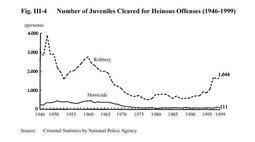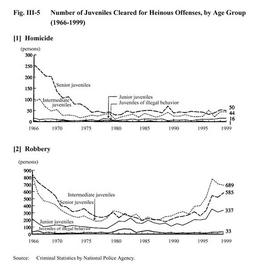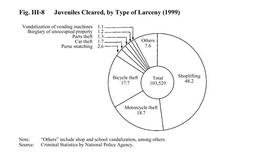| Previous Next Index Image Index Year Selection | |
|
|
3 Trends by category of offenses (1)Heinous offenses
Fig. III-4 shows the number of juveniles cleared by the police for homicide and robbery since 1946 (see Appendix III-4 for the number of juveniles cleared by category of major penal code offense). Fig. III-4 Number of Juveniles Cleared for Heinous Offenses (1946-1999) After falling below 100 in the early 1970s, the number of juveniles cleared for homicide largely stayed within the range of 70-90, only to exceed 100 again in 1998. It stood at 111 in 1999 (down 5.1% from the previous year). As regards robbery, the number of juveniles cleared tended to decline after peaking at 2,762 in 1960, falling below 1,000 in 1971 at 869. The number subsequently declined gradually or stayed on a par, with some fluctuations, but began to show an upward trend in 1989, exceeding 1,000 in 1996 and increasing rapidly in 1997 to 1,701. It stood at 1,644 in 1999 (up 5.0% from the previous year).Per 100,000 persons, the number of juveniles cleared for homicide has constantly stayed below 1.0 since 1971, with some fluctuation. The number for robbery showed a downward trend until 1979 after dropping below 10.0 in 1964. Following some fluctuations, it has been in an upward trend since 1989, reaching 11.4 in 1999 (see Appendix III-5 for the rate per population of juveniles cleared by category of major penal code offense). Fig. III-5 shows the number of juveniles cleared for heinous offenses since 1966, by age group. Fig. III-5 Number of Juveniles Cleared for Heinous Offenses, by Age Group (1966-1999) As regards homicide, senior juveniles have had the largest share in the total number of juveniles cleared in every year except 1996. The number of senior juveniles cleared decreased substantially from 257 in 1966 and stayed within the 30-40 range in the early 1990s. However, it exceeded 50 in 1998 and 1999. The number of intermediate juveniles cleared for homicide remained at just over 20 from 1990 except in 1992 and 1996, but exceeded 40 in 1998 and 1999. The number of junior juveniles cleared has never reached 20. It stood at 16 in 1999. As for juveniles of illegal behavior, the number has been zero or in single digits. Only one juvenile of illegal behavior was cleared for homicide in 1999.The number of juveniles cleared for robbery remained largely on a par, with slight fluctuation, from the late 1970s in all age groups except juveniles of illegal behavior. However, it has been showing signs of increase in recent years, regardless of age. The number of senior juveniles cleared for robbery turned up in1990 to reach 585 in 1999 (up 12.5% from the previous year). As regards intermediate juveniles, the number decreased for the second year running in 1999 to 689 (down2.7%), following an upward trend recorded from 1989. The number of junior juveniles cleared for robbery turned up in 1993 and has exceeded 300 since 1997. It stood at 337 in 1999 (up 9.7%). The number for juveniles of illegal behavior remained in the 10-20 range from 1988 but rose to 33 in 1999(up 17.9%). (2) Violent offenses Fig. III-6 shows the number of juveniles cleared for bodily injury, assault, intimidation and extortion since 1946. Fig. III-6 Trends in Number of Juveniles Cleared for Violent Offenses (1946-1999) The number of juveniles cleared for bodily injury, assault and extortion rose significantly in the late 1950s, a movement that corresponds to the second wave of juvenile delinquency mentioned above. It declined rapidly in the late 1960s, only to turn up in the early 1980s, peaking in 1982 for bodily injury, in 1981 for assault and in 1986 for extortion. Following a subsequent downward trend until 1995 and an upward trend from 1996, the number declined in every category in 1999, totaling 9,244 for bodily injury (down 6.8% from the previous year), 1,652 for assault (down 10.6%) and 6,315 for extortion (down 6.7%).The number of juveniles cleared for bodily injury per 100,000 persons stayed within the range of 80 from the late 1950s to early 1960s, reflecting the second wave of juvenile delinquency. It fell rapidly from the late 1960s to nearly half the number recorded during the peak period (41.6) in 1979. Subsequently, the number turned up and peaked at 64.3 in 1982, followed by a temporary downward trend. It has shown an upward movement since 1994, reaching 64.1 in 1999. (3) Property offenses Fig. III-7 shows trends in the number of juveniles cleared for larceny, fraud and embezzlement including conversion of lost property. In parallel with the overall trend of juvenile penal code offenses, three waves can be observed for larceny committed by juveniles, peaking in 1951, 1963 and 1983, respectively. The number of juveniles cleared for larceny has been in a downward trend since 1983, when it peaked at 202,028. Most recently, it has remained on a par at around 100,000, totaling 103,529 in 1999 (down 14.6% from the previous year). Likewise, three waves can be observed in the number cleared for larceny per 100,000 juveniles, each peaking in 1951 (724.5), 1964 (677.1) and 1981 (1,118.3). The number showed a downward trend from 1982, followed by an increase from 1996. In 1999, however, it declined from the previous year to 718.2. Juveniles cleared for embezzlement have numbered around 30,000 since 1991 and stood at 34,862 in 1999 (down 2.7% from the previous year). Almost 100% of the juveniles were cleared for conversion of lost property, mostly for riding on abandoned bicycles. The ratios of larceny and embezzlement in the total number of juveniles cleared for penal code offenses other than traffic professional negligence amounted to 63.0% and 21.2% respectively in 1999, thus accounting for more than 80% of the total between them (see Appendix III-3 ). Fig. III-7 Trends in Number of Juveniles Cleared for Property Offenses (1946-1999) Fig. III-8 shows a breakdown of the number of juveniles cleared in 1999, by type of larceny. Shoplifting accounts for about half of the total, followed by motorcycle theft and bicycle theft.Fig. III-8 Juveniles Cleared, by Type of Larceny (1999) |




